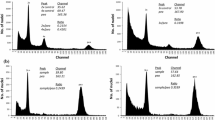Summary
While constructing a genetic linkage map of a hybrid poplar genome (Populus trichocarpa x P. deltoides), we identified several restriction fragment length polymorphismus (RFLPs) for which the parental trees are heterozygous. Although 8 of the 11 F1 hybrid offspring inherited, as expected, single RFLP alleles from each parent, 3 F1 trees in the mapping pedigree inherited both maternal alleles along with a single paternal allele at some loci. Aneuploidy or polyploidy in these 3 F1 trees due to partial or complete nondisj unction during female gametogenesis is the simplest explanation for this finding. Of the 3 f1 offspring with supernumerary RFLP alleles 2 have triploid nuclear DNA contents as measured by fluorescence flow cytometry; the 3rd F1 with supernumerary alleles has a sub-triploid nuclear DNA content and is probably aneuploid. Among the tri/aneuploid hybrids, leaf quantitative traits either are skewed toward those values characteristic of the P. trichocarpa female parent (adaxial stomate density, petiole length: blade length ratio; abaxial color) or show transgressive variation (epidermal cell size). Abaxial leaf color was used to screen a large population of P. trichocarpa x P. deltoides hybrids for further evidence of tri/aneuploidy. In each case where a “white” abaxial leaf surface was observed and the nuclear DNA content measured, the hybrid proved to be tri/aneuploid. All sexually mature female triploids examined were sterile, although the inflorescences completed their development in the absence of embryo formation. The (probably) aneuploid F1 hybrid is a fertile female. Of 15 female P. trichocarpa parents used in crosses to P. deltoides, 10 produced one or more tri/aneuploid hybrid offspring. In an intraspecific cross using a P. trichocarpa female that had produced triploid hybrids with five different P. deltoides males, no tri/aneuploid offpsring were found.
Similar content being viewed by others
References
Brayshaw TC (1965) Native poplars of southern Alberta and their hybrids. Can Dep For Publ No. 1109, Ottawa
Church GM, Gilbert W (1984) Genomic sequencing. Proc Natl Acad Sci USA 81:1991–1995
Dhillon SS (1987) DNA analysis during growth and development. In: Hanover JW, Keathley DE (eds). Genetic manipulation of woody plants. Plenum Press, New York, pp 265–274
Dickmann DI, Stuart KW (1983) The culture of poplars in eastern North America. Michigan State University Press, East Lansing, Mich.
Dunlap JM (1991) Genetic variation in natural populations of Populus trichocarpa T.&G. from four river valleys in Washington. PhD thesis, University of Washington, Seattle, Wash.
Eckenwalder JE (1977) Systematics of Populus L. (Salicaceae) in southwestern North America with special reference to Sect. Aigeros Duby. PhD thesis, University of California, Berkeley, Calif.
Figliola AL (1986) Studies in the physiology, morphology, and anatomy of Populus trichocarpa, Populus deltoides, and their hybrids. MSc Thesis, University of Washington, Seattle, Wash.
Guries RP, Stettier RF (1976) Pre-fertilization barriers to hybridization in the poplars. Silvae Genet 25:37–44
Harlow WM, Harrar ES, White FM (1979) Textbook of dendrology. McGraw-Hill, New York
Heilman PE, Stettier RF (1985) Genetic variation and productivity of Populus trichocarpa T.&G. and its hybrids. II. Biomass production in a 4-year plantation. Can J For Res 15:384–388
Hinckley TM, Ceulemans R, Dunlap JM, Figliola A, Heilman PE, Isebrands JG, Scarascia-Mugnozza G, Schulte PJ, Smit B, Stettler RF, Van Volkenburgh E, Wiard BM (1989) Physiological, morphological, and anatomical components of hybrid vigor in Populus. In: Kreeb KH, Richter H, Hinckley TM (eds) Structural and functional responses to environmental stresses. SPB Academic Publ, The Hague, The Netherlands, pp 199–217
Keim P, Paige KN, Whitham TG, Lark KG (1989) Genetic analysis of an interspecific hybrid swarm of Populus: occurrence of unidirectional introgression. Genetics 123:557–565
Larson PR, Isebrands JG (1971) The plastochron index as applied to developmental studies of cottonwood. Can J For Res 1:1–11
Maniatis T, Fritsch EF, Sambrook J (1982) Molecular cloning: A laboratory manual. Cold Spring Harbor Laboratory Press, Cold Spring Harbor, N.Y.
Mirsky AE, Ris H (1949) Variable and constant components of chromosomes. Nature 163:666–669
Parsons TJ, Bradshaw HD, Gordon MP (1989) Systemic accumulation of specific mRNAs in response to wounding in poplar trees. Proc Natl Acad Sci USA 86:7895–7899
Ridge CR, Hinckley TM, Stettler RF, Van Volkenburgh E (1986) Leaf growth characteristics of fast growing poplar hybrids Populus trichocarpa x P. deltoides. Tree Physiol 1:209–216
Stebbins GL (1950) Variation and evolution in plants. Columbia University Press, New York
Stettler RF, Bawa KS (1971) Experimental induction of haploid parthenogenesis in black cottonwood (Populus trichocarpa T.&G. ex Hook). Silvae Genet 20:15–25
Swanson CP (1957) Cytology and cytogenetics. Prentice-Hall, Englewood Cliffs, N.J.
van Buijtenen JP, Joranson PN, Einspahr DW (1958) Diploid versus triploid aspen as pulpwood sources with reference to growth, chemical, physical, and pulping differences. TAPPI 41:170–175
Zsuffa L (1975) A summary review of interspecific breeding in the genus Populus. In: Fowler DP, Yeatman CW (eds) Proc 14th Meeting Can Tree Improv Assoc, part 2. Fredericton, New Brunswick, pp 107–123
Author information
Authors and Affiliations
Additional information
Communicated by P.M.A. Tigerstedt
Rights and permissions
About this article
Cite this article
Bradshaw, H.D., Stettler, R.F. Molecular genetics of growth and development in Populus. I. Triploidy in hybrid poplars. Theoret. Appl. Genetics 86, 301–307 (1993). https://doi.org/10.1007/BF00222092
Received:
Accepted:
Issue Date:
DOI: https://doi.org/10.1007/BF00222092




